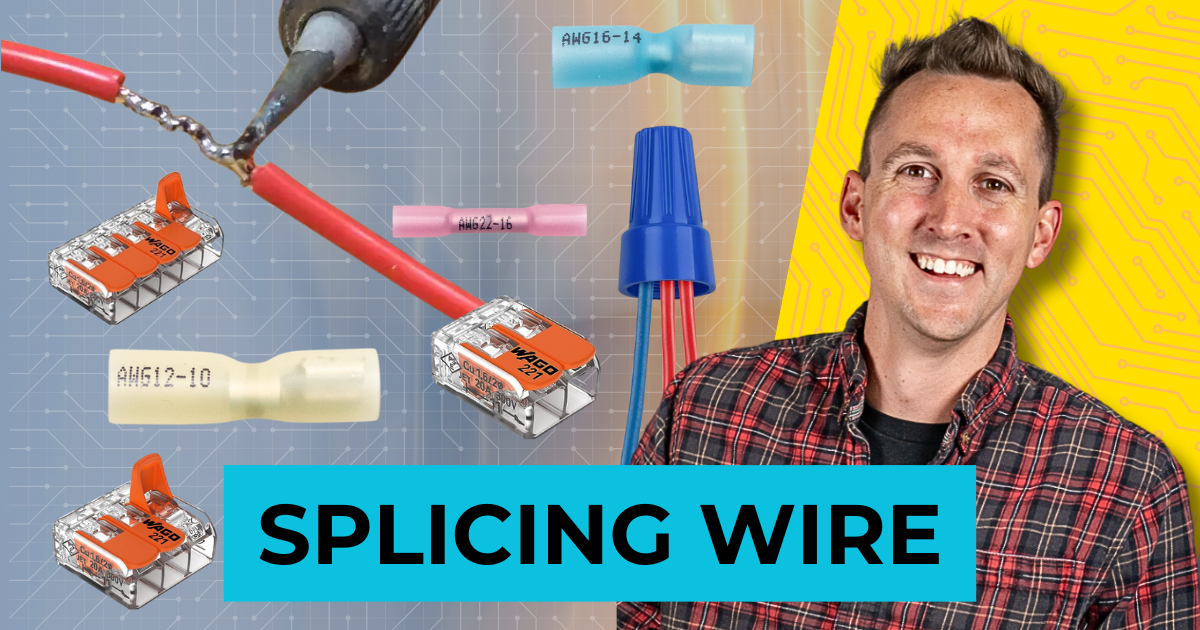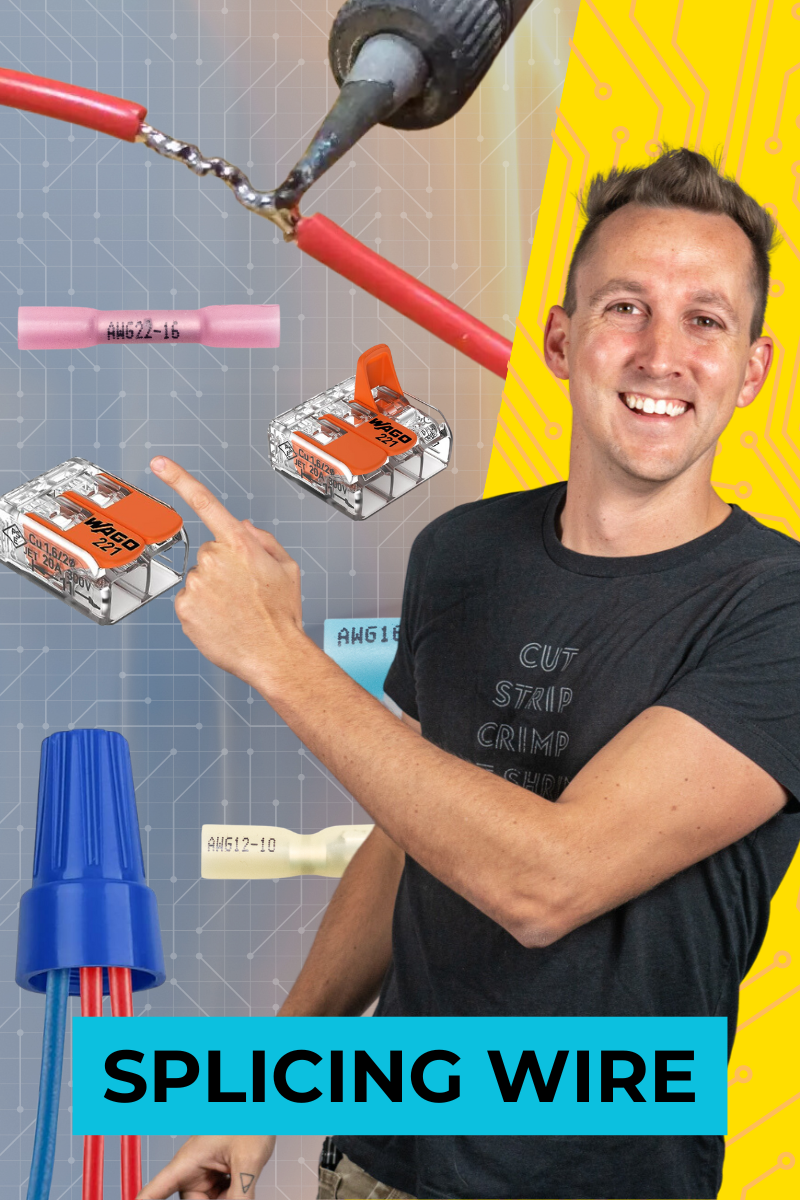If you need to connect two wires together to extend them, there are several different ways to do it; some are good, and some are bad and teaching you about the different ways to splice wire together is exactly what I’m going to cover.
Now, instead of just showing you my single preferred way of splicing wire, I’m going to show you some splicing methods I’ve seen or done and then rank them on how good they are, in my opinion.
Splicing Wire VIDEO
Lever Nuts

If you have two or more wires, 10 AWG or smaller, you need to join together, lever nuts are a fantastic option and I use them all the time. They have a little lever on the front that flips up so you can insert the wire, and then locks down to keep the wire in place. If you need to re-do the splice, the lever can just be lifted back up to release the wire. They may not seem that secure at first glance, but we’ve done some pretty extensive testing on them here at our shop; and they are pretty impressive.
Lever Nuts – The downside
They don’t come in options larger than 10 AWG
They aren’t watertight so they may not be appropriate for wet locations.
Lever Nuts – Rated
I give lever nuts a 10/10 rating. Any time it is appropriate to use them, I’m always going to opt for them due to their ease of use, how easy they are to inspect, and how solid of a connection they make.
Butt Splice Connectors

Butt Splice crimp connectors let us:
- put a wire into one side
- crimp it into place with insulated terminal crimpers
- Put the other wire in the opposite side
- Crimp it into place
And now you’ve got a very secure electrical connection. Butt splice connectors come in two versions: Insulated and Heat Shrink.
The insulated ones come with a simple Nylon covering that protects the wire from touching anything else; but my favorite butt splice connectors come with an adhesive lined heat shrink coating pre-installed that melts and shrinks down to grab onto the insulation of the wire for additional strain relief and also makes the connection completely weatherproof.
Butt Splice Connectors – The Downsides
The only ‘downside’ to this connection is that it cannot be un-done without cutting the splice off and re-doing it, but a ‘removable’ splice isn’t always desired. Pick your poison.
Butt Splice Connectors – Rated
If you have two wires of the same size and need a permanent splice, it’s hard to beat a butt splice connector with adhesive lined heat shrink pre-attached and I also give these a 10/10.
Terminal Blocks

We use Terminal Blocks when we need to join two or more wires together at 10AWG or larger. You can see these in use in our OEM RV splice boxes where we may need to connect multiple 10 AWG and 6 AWG wires to OEM 10 and 6 ga wires.
A terminal block is a screw terminal connection and works with a range of sizes and can be color coded depending on its use and these terminal blocks are connected, electrically, top to bottom, and you can also join multiple terminal blocks together, electrically, with a terminal block jumper, which you can see in use in our Dual Multiplus splitter box.
Terminal Blocks – The Downsides
Terminal blocks are designed to be installed on a DIN rail; and the DIN rail needs to be mounted inside of a din rail junction box; which makes this connection somewhat costly and pretty bulky.
Terminal Blocks – Rated
I rate these at a 9/10, docking a point because they are bulky, but their electrical connection methods and their flexibility of installation simply can’t be beat.
Mesh Splice

A mesh splice is a way to splice two or more wires together by ‘meshing’ their wire strands together, twisting them into place, then covering them with heat shrink.
Mesh Splice – The Downsides
There is nothing physically holding the connection together except for the friction of the wire strands which makes this not a particularly strong connection.
Mesh Splice – Rated
Although this works in a pinch, it’s not strong enough for me to be inherently comfortable with and should be a last resort. If you do find yourself where this is actually the best option; I’d definitely recommend zip tying each side of the splice to something solid so nothing is pulling on the connection. I rate this one at 3/10.
Soldered Connection

To make the Mesh Splice significantly stronger, you could solder the mesh spliced connection and that would pretty much remove all doubt on if the connection would pull apart.
Soldered Connection – The Downsides
Soldering, and therefore super-heating the wire can make a weak point where the wire goes from hot to cold and is prone to work-hardening, becoming brittle, and breaking. This is why the ABYC specifically forbids or restricts the use of soldered connections (ABYC E-11.15.3.8)
Soldered connection – Rated
The downsides of soldering with work-hardening (plus the fact that it takes a bit of practice to get good at soldering) puts this connection at a 4/10 for me.
Solder Seal

Solder Seal is a specific brand or type of butt splice connector that is essentially a piece of adhesive-lined heat shrink tubing that has a little band of solder on the inside.
In theory, we should be able to put this over a meshed connection, heat the connection, and the heat shrink will shrink and the solder will melt, fusing the wires together.
Solder Seal – The Downsides
I’ve really wanted to like these, but I’ve struggled to get the connection to work without a stray wire strand stabbing through the insulation, burning myself, or keeping the connection together when working in a tight space.
Solder Seal – Rated
I’m going to rate these at 4/10, the same as a regular soldered connection, and I think these would still be forbidden by the ABYC since the solder is the only thing holding the wires together but these are basically the same form factor as a butt splice crimp connector; so if a solder seal connection would work… you may as well just use a butt splice crimp connector and remove all doubt.
Wire Nuts

Wire Nuts have been the industry standard for residential wiring here in the USA for decades; and they work fine. They simply twist onto the ends of stripped wire, joining and protecting the connection.
Wire Nuts – The Downsides
In mobile and marine applications, the vibrations of the engine running can, over time, loosen the wire nut and create a loose connection. This is so much of a hazard that the ABYC specifically forbids their use in marine based electrical systems.
Wire Nuts – Rated
I have two ratings here, depending on their use case:
For residential applications, I give these a 6/10. These basically do the same thing as a lever nut; but a lever nut is easier to use, easier to inspect, and a nicer form factor.
For Mobile or Marine applications: 0/10 since they are specifically forbidden with no exceptions by the ABYC.
Twist, Tape & Pray

We see this one a lot when we are fixing broken systems at the various events we go to throughout the year. You’ll just strip back some wire, twist them together, wrap it with painters tape and call it a day. Not judging… okay… judging a little… but yes; we’ve seen this.
Twist, Tape & Pray – The Downsides
Basically everything. It’s not a solid electrical connection and you can expect it to come loose pretty quickly. It doesn’t show good workmanship. The only time I’m going to use this is if I’m tabletop testing some 12V circuits to see if something will work or not; but I would never-ever use this in a permanent situation.
Twist, Tape & Pray – Rated
-3/10. It’s easy. That is literally its only positive attribute.
Lever nuts, butt splice connectors, and terminal blocks are my go-to’s and I pretty much don’t use anything else.
For me… if I’m having to splice larger wire or do something that falls outside of what can be achieved with those three options, something has gone wrong and I’m going to take a step back and ask myself if what I’m attempting is actually good system design and re-work as necessary so I’m not cutting corners.



